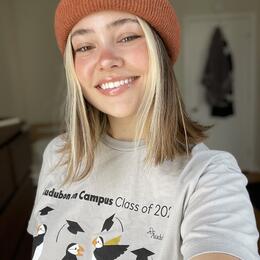Many agree that spring is the time of year for new beginnings — after all, plant life leaping from the ground with birdsong carrying weightlessly on the air is the perfect backdrop to start anew like many species in our world elect to. But at Richardson Bay, winter is a time of profound change and freshness, and this year was no exception.
Although the species themselves might not be unexpected, the arrival of our wintering sea ducks is always highly anticipated, and this year they arrived in droves. American Coots (Fulica americana) were the first to show up, followed by Buffleheads (Bucephala albeola), Common Goldeneyes (Bucephala clangula) and Lesser Scaup (Aythya affinis). A glance out over the Bay might include various gulls and Brown Pelicans (Pelecanus occidentalis) soaring conspicuously, but a closer look often reveals the small yet distinct bobbing heads of dozens, sometimes hundreds, of sea ducks floating in the water. Most of the ducks travel from Alaska and stop at Richardson Bay for the winter to rest and refuel before seeking warmer weather further south. Occasional feeding frenzies spurred by a visitation of unlucky schools of Pacific Herring (Clupea pallasii) draw upwards of thousands of birds, including Brandt's (Urile penicillatus), Double-Crested (Phalacrocorax auritus) and Pelagic (Urile pelagicus) Cormorants, to the Bay to feed.
However, birds aren't the only migrants we host at the Center — an unprecedented explosion of Monarch Butterflies (Danaus plexippus) in the fall left everyone in at Richardson Bay in awe. California Sender Salamanders (Batrachoseps attenuatus) were seen for the first time ever on the property, and our freshy-installed BirdPi technology revealed the presence of a resident Great Horned Owl (Bubo virginianus).
With life bursting at the seams in every direction, it follows that our demonstration gardens have been thriving as well. With the help of drop-in volunteers, school groups like Marin Country Day School, and Audubon Youth Leaders, a generous grant of seedlings from the Xerxes Society in Napa have been planted in our Native Plant Garden and Bird Garden. These plants will help other endemic species find their footing on the property by providing habitat, food, and mutually beneficial pollinator services to birds, butterflies, and bees. With winter rains arriving in earnest, these new seedlings will soon have all the resources they need to flourish and will bring us one step closer to building bird-friendly communities.
Despite much change, it is important to remind ourselves of all the things that stay the same, including our strong rapport with the community of Tiburon. Without our relationships with the many people who treasure Richardson Bay, we would be unable to conserve it, and we are grateful for the endless support. We hope that the New Year is filled with just as many exciting discoveries as it is with renewed connections, and that you join us in our pursuit of a more sustainable and equitable world, one Bay at a time.
News
Winter Wonderland: Richardson Bay Abounds with Seasonal Visitors
With familiar faces joining new friends, winter at the Center has been prolific.








